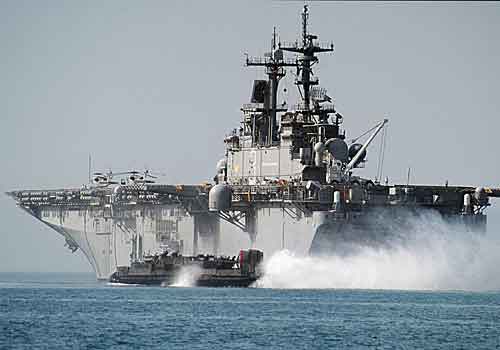The South China Sea: US again stirring up trouble behind hypocritical excuses
New York Times backs reckless US intervention in South China Sea

WSWS.ORG, a socialist organization
Thank you, WSWS.ORG
The New York Times has once again stepped forward as the apologist for and promoter of the Obama administration’s aggressive foreign policy—this time in the South China Sea.
An editorial last weekend entitled “Asia’s Roiling Sea” drew attention to rising tensions in these strategic waters. Declaring that competition between China and its neighbours had become “a virtual free-for-all”, it warned: “Confrontations over territorial control are alarmingly frequent and could get out of hand, with dangerous consequences.”
The Times proceeds to blame China for this dangerous situation, stating: “There is no question that China’s economic power and its assertive use of its navy and commercial vessels to project influence has changed the regional dynamics and worried many of its neighbours.” It points to Beijing’s territorial claims in the South China Sea and to recent events, including the naval standoff near the disputed Scarborough Shoal and the stationing of a small Chinese garrison on its island of Yongxing.
As for the Obama administration, the Times presents its intervention into these disputes as guided by the purest of motives. “The United States is worried, and rightly so,” the newspaper declared, adding that it had to ignore China’s outbursts, “and continue to play a role in seeking a peaceful resolution to such disputes.”
The editorial represents the height of cynicism. The chief responsibility for inflaming tensions in the South China Sea, and throughout Asia, rests squarely with the Obama administration. During the 2008 presidential election campaign, Obama was backed by sections of the American foreign policy establishment that believed that President Bush’s preoccupation with the Middle East had allowed China’s influence in Asia to expand at Washington’s expense.
In mid-2009, Secretary of State Hillary Clinton declared at an Association of South East Asian Nations (ASEAN) summit that the US was “back in Asia”, launching what she has since dubbed a “pivot” from the Middle East to Asia. For the past three years, the Obama administration has built up American military forces in the region, strengthened alliances and strategic partnerships, and played a hand in removing political leaders—including Australian Prime Minister Kevin Rudd and his Japanese counterpart Yukio Hatoyama—who failed to fully support its aggressive moves. In a speech to the Australian parliament last November, Obama summed up his administration’s shift to Asia, bluntly declaring that “the United States is a Pacific power, and we are here to stay.”
The longstanding disputes in the South China Sea have been one of the issues that Washington has exploited to drive a wedge between China and countries in South East Asia. At an ASEAN summit in mid-2010, Clinton stated for the first time that the US had “a national interest” in ensuring “freedom of navigation” in the South China Sea. She also offered to mediate in the territorial disputes, effectively undermining a decade of Chinese diplomacy aimed at resolving the outstanding issues bilaterally with its neighbours.
Under the banner of “freedom of navigation”, the US is reasserting its naval dominance over strategic waters close to the Chinese mainland and, in doing so, encouraging countries like the Philippines and Vietnam to more aggressively press their territorial claims against China.
There is nothing benign or “neutral”—as the Times would have it—about Washington’s activities in the South China Sea. The US has fully backed its ally and former colony, the Philippines in its standoff with China. Clinton has hinted on several occasions that the US would come to the aid of the Philippines under their Mutual Defence Treaty in the event of conflict with China.
Moreover, the Obama administration has been actively strengthening the Philippines armed forces. In a recent confrontation with China over the disputed Scarborough Shoal, the vessel first deployed to the area was a former US coastguard cutter that had been supplied to the Philippines last year. Another is due to be provided soon, along with more sophisticated war planes and other military hardware.
Washington is also in discussion with Manila over an agreement to access Philippine military bases. This will be along the lines of an arrangement announced last November in Canberra that places Marines in Darwin and expands the US use of Australian naval and air bases. These moves are part of a comprehensive strategy that includes basing new American littoral combat ships in Singapore and seeking access to bases in Vietnam and Thailand. Defense Secretary Leon Panetta has announced plans to place 60 percent of US naval forces in the Asia-Pacific region.
American naval dominance of the South China Sea—as well as key “choke points” through South East Asia, such as the Malacca Strait—pose a direct threat to China, which relies on these shipping routes to import energy and raw materials from the Middle East and Africa. In the event of a conflict, the US could impose an economic blockade on China—similar to its oil embargo against Japan in 1941, which triggered the Pacific War.
Through its reckless actions, the Obama administration has transformed what were previously relatively minor maritime disputes into a major international issue involving the world’s two largest economies. The South China Sea has become another dangerous flashpoint in Asia—like the Korean peninsula and the Taiwan Strait.
The divisions were evident at last month’s ASEAN ministerial summit. On one side, the Philippines and Vietnam, supported by the US, pressed for a discussion on a regional “code of conduct”. The Philippines even insisted that its dispute with China over the Scarborough Shoal be mentioned in the final communiqué. These proposals were opposed by Cambodia, backed by China, and, for the first time in ASEAN’s history, no final joint statement was issued. It is little wonder that the US intervention has provoked an increasingly angry reaction in Beijing.
Nor is the South China Sea the only arena in which the US has deliberately stoked up tensions. The New York Times makes passing reference to the latest diplomatic row between China and Japan over the disputed Senkaku/Diaoyu islands in the East China Sea. Once again, with the Obama administration’s encouragement, the Japanese government has taken a far more aggressive stance. Most recently, Prime Minister Yoshihiko Noda provocatively indicated that he might “nationalise” the islands by buying them from their private owner.
In concluding its editorial, the Times called on ASEAN to effectively thumb its nose at China and implement “a code of conduct”, declaring “Washington’s should not be the sole voice for a peaceful resolution” to the South China Sea disputes. All this demonstrates is that in the name of “peace”, the US is dangerously raising the political temperature in this trouble spot even as it prepares for a potentially catastrophic conflict with China. And the New York Times, along with the rest of the compliant American media, is acting as its accomplice, as it did during the criminal wars in Afghanistan, Iraq and Libya.
Let’s keep this award-winning site going!
| Yes, audiences applaud us. But do you?If yes, then buy us a beer. The wingnuts are falling over each other to make donations…to their causes. We, on the other hand, take our left media—the only media that speak for us— for granted. Don’t join that parade, and give today. Every dollar counts. |
|---|
| Use the DONATE button below or on the sidebar. And do the right thing. Even once a year. |
Use PayPal via the button below.
THANK YOU.

